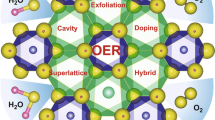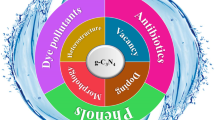Abstract
This work proposes a new strategy to prepare a hematite (α-Fe2O3) bilayer photoanode by hydrothermally depositing α-Fe2O3 (B) on the α-Fe2O3 (A) films prepared by electrochemical deposition. Compact smooth surfaced α-Fe2O3 (A) films were electrochemically deposited on FTO (SnO2:F) substrates from an aqueous bath. The α-Fe2O3 (A), α-Fe2O3 (B), and α-Fe2O3/α-Fe2O3 bilayer films’ characteristics were defined by X-ray diffraction (XRD) measurements, field emission scanning electron microscopy (FESEM), and energy-dispersive X-ray (EDX) spectroscopy. Pure crystalline α-Fe2O3 (B) films with a typical anisotropic-like nanoparticle formation, which exhibited nanostructured rods covering the substrate and formed the characteristic mesoporous film morphology, were hydrothermally deposited on α-Fe2O3 (A) films prepared by electrochemical depositing in a solution bath at 25 °C and a potential of − 0.15 V. The photocurrent measurements exhibited increased intrinsic surface states (or defects) at the α-Fe2O3 (A)/α-Fe2O3 (B) interface. The photoelectrochemical performance of the α-Fe2O3 (A)/α-Fe2O3 (B) structure was examined by chronoamperometry, which found that the α-Fe2O3 (A)/α-Fe2O3 (B) structure exhibited greater photoelectrochemical activity than the α-Fe2O3 (A) and α-Fe2O3 (B) thin films. The highest photocurrent density was obtained for the bilayer α-Fe2O3 (A)/α-Fe2O3 (B) films in 1 M NaOH electrolyte. This great photoactivity was ascribed to the highly active surface area, and to the externally applied bias that favored the transfer and separation of photogenerated charge carriers in α-Fe2O3 (A)/α-Fe2O3 (B). The improved photocurrent density was attributed to an appropriate band edge alignment of semiconductors and to enhanced light absorption by both semiconductors. The best performing samples were α-Fe2O3 (A)/α-Fe2O3 (B), which reached the maximum incident photon conversion efficiencies (IPCE) of 400 nm at the potential of 0.1 V. In this case, the IPCE values were 3-fold higher than those of the α-Fe2O3 (A) and α-Fe2O3 (B) films.













Similar content being viewed by others
References
Brimblecombe R, Dismukes GC, Swiegers GF, Spiccia L (2009) Molecular water-oxidation catalysts for photoelectrochemical cells. Dalton Trans 0:9374–9384
Prévot MS, Sivula K (2013) Photoelectrochemical tandem cells for solar water splitting. J Phys Chem C 117(35):17879–17893
Valdés Á, Brillet J, Grätzel M, Gudmundsdóttir H, Hansen HA, Jónsson H, Klüpfel P, Kroes GJ, Formal FL, Man IC, Martins RS, Nørskov JK, Rossmeisl J, Sivula K, Vojvodic A, Zäch M (2012) Solar hydrogen production with semiconductor metal oxides: new directions in experiment and theory. Phys Chem Chem Phys 14(1):49–70
Murphy AB, Barnes PRF, Randeniya LK, Plumb IC, Grey IE, Horne MD, Glasscock JA (2006) Efficiency of solar water splitting using semiconductor electrodes. Int J Hydrog Energy 31(14):1999–2017
Chen Z, Jaramillo TF, Deutsch TG, Kleiman-Shwarsctein A, Forman AJ, Gaillard N, Garland R, Takanabe K, Heske C, Sunkara M, McFarland EW, Domen K, Milled EL, Dinh HN (2010) Accelerating materials development for photoelectrochemical hydrogen production: standards for methods, definitions, and reporting protocols. J Mater Res 25(01):3–16
Sivula K, Formal FL, Grätzel M (2011) Solar water splitting progress using hematite (α-Fe2O3) photoelectrodes. ChemSusChem 4(4):432–449
Dauth A, Love JA (2012) Synthesis and reactivity of 2-azametallacyclobutanes. Dalton Trans 41:7830–7834
Kennedy JH, Frese KW (1978) Photooxidation of water at α-Fe2O3 electrodes. J Electrochem Soc 125(5):709–714
Wheeler DA, Wang G, Ling Y, Li Y, Zhang JZ (2012) Nanostructured hematite: synthesis, characterization, charge carrier dynamics, and photoelectrochemical properties. Energy Environ Sci 5(5):6682–6702
Regan BO, Schwartz DT (1995) Efficient photo-hole injection from adsorbed cyanine dyes into electrodeposited copper (I) thiocyanate thin films. Chem Mater 7(7):1349–1354
Li B, Wang L, Kang B, Wang P, Qiu Y (2006) Review of recent progress in solid-state dye-sensitized solar cells. Sol Energy Mater Sol Cells 90(5):549–573
Formal FL, Grätzel M, Sivula K (2010) Controlling photoactivity in ultrathin hematite films for solar water-splitting. Adv Funct Mater 20(7):1099–1107
Hisatomi T, Dotan H, Stefik M, Sivula K, Rothschild A, Grätzel M, Mathews N (2012) Enhancement in the performance of ultrathin hematite photoanode for water splitting by an oxide underlayer. Adv Mater 24(20):2699–2702
Luo W, Yu T, Wang Y, Li Z, Ye J, Zou Z (2007) Enhanced photocurrent–voltage characteristics of WO3 /Fe2O 3 nano-electrodes. J Phys D Appl Phys 40(4):1091–1096
Boudoire F, Toth R, Heier J, Braun A, Constable EC (2014) Photonic light trapping in self-organized all-oxide microspheroids impacts photoelectrochemical water splitting. Energy Environ Sci 7(8):2680–2688
Hsu YK, Chen YC, Lin YG (2015) Novel ZnO/Fe2O3 core–shell nanowires for photoelectrochemical water splitting. ACS Appl Mater Interfaces 7(25):14157–14162
Sharma D, Upadhyay S, Verma A, Satsangi VR, Shrivastav R, Dass S (2015) Nanostructured Ti-Fe2O3/Cu2O heterojunction photoelectrode for efficient hydrogen production. Thin Solid Films 574:125–131
Bouhjar F, Ullah S, Chourou ML, Mollar M, Marí B, Bessaïs B (2017) Electrochemical fabrication and characterization of p-CuSCN/n-Fe2O3 heterojunction devices for hydrogen production. J Electrochem Soc 164:936–945
Bouhjar F, Mollar M, Chourou ML, Marí B, Bessaïs B (2018) Hydrothermal synthesis of nanostructured Cr-doped hematite with enhanced photoelectrochemical activity. Electrochim Acta 260:838–846
Jaramillo TF, Baeck SH, Kleiman-Shwarsctein A, Choi KS, Stucky GD, McFarland EW (2005) Automated electrochemical synthesis and photoelectrochemical characterization of Zn1-xCoxO thin films for solar hydrogen production. J Comb Chem 7(2):264–271
Jaramillo TF, Baeck SH, Kleiman-Shwarsctein A, McFarland EW (2004) Combinatorial electrochemical synthesis and screening of mesoporous ZnO for photocatalysis. Macromol Rapid Commun 25(1):297–301
Miller EL, Paluselli D, Marsen B, Rocheleau RE (2004) Low-temperature reactively sputtered iron oxide for thin film devices. Thin Solid Films 466(1-2):307–313
Belkhedkar MR, Ubale AU (2014) Preparation and characterization of α-Fe2O3 thin films grown by successive ionic layer adsorption and reaction method. Mater Chem 4:109–116
Shinde SS, Bansode RA, Bhosale CH, Rajpure KY (2011) Physical properties of hematite α-Fe2O3 thin films: application to photoelectrochemical solar cells. J Semicond 32:0–8
Souza FL, Lopes KP, Nascente PAP, Leite ER (2009) Nanostructured hematite thin films produced by spin-coating deposition solution: application in water splitting. Sol Energy Mater Sol Cells 93(3):362–368
Sookhakian M, Amin YM, Baradaran S, Tajabadi MT, Golsheikh AM, Basirun WJ (2014) A layer-by-layer assembled graphene/zinc sulfide/polypyrrole thin-film electrode via electrophoretic deposition for solar cells. Thin Solid Films 552:204–211
Qing Y, Xianguang M, Tao W, Peng L, Jinhua Y (2015) Hematite films decorated with nanostructured ferric oxyhydroxide as photoanodes for efficient and stable photoelectrochemical water splitting. Adv Funct Mater 25:2686–2692
Qing Y, Xianguang M, Li S, Guigao L, Peng L, Jinhua Y (2016) Hematite homojunctions without foreign element doping for efficient and stable overall water splitting. RSC Adv 6:62263–62269
Miao Z, Takashi H, Yongbo K, Jiao Z, Min L, Akihide I, Qingxin J, Hiroshi N, Tsutomu M, Mamiko N, Naoya S, Ryo N, Chisato K, Hidetaka S, Masao K, Akihiko K, Taro Y, Kazunari D (2015) Surface modification of CoOx loaded BiVO4 photoanodes with ultrathin p-type NiO layers for improved solar water oxidation. J Am Chem Soc 137:5053–5060
Gardner RFG, Sweett F, Tanner DW (1963) The electrical properties of alpha ferric oxide-II. J Phys Chem Solids 24(10):1183–1196
Dare-Edwards MP, Goodenough JB, Hamnett A, Trevellick PR (1983) Electrochemistry and photoelectrochemistry of iron(II1) oxide. J Chem SOC Faraday Trans I 79(9):2027–2041
Cesar I, Sivula K, Kay A, Zboril R, Grätzel M (2009) Influence of feature size, film thickness, and silicon doping on the performance of nanostructured hematite photoanodes for solar water splitting. J Phys Chem C 113(2):772–782
Funding
This work was supported by the Ministry of High Education and Scientific Research (Tunisia), Research and Technology Centre of Energy (CRTEn) Borj-Cedria, and the Spanish Ministerio de Economia y Competitividad (ENE2016-77798-C4-2-R), and the Generalitat valenciana (Prometeus 2014/044).
Author information
Authors and Affiliations
Corresponding author
Rights and permissions
About this article
Cite this article
Bouhjar, F., Bessaïs, B. & Marí, B. Ultrathin-layer α-Fe2O3 deposited under hematite for solar water splitting. J Solid State Electrochem 22, 2347–2356 (2018). https://doi.org/10.1007/s10008-018-3946-7
Received:
Revised:
Accepted:
Published:
Issue Date:
DOI: https://doi.org/10.1007/s10008-018-3946-7




